The campus of the University of California, Berkeley, and its surrounding community are home to a number of notable buildings by early 20th-century campus architect John Galen Howard, his peer Bernard Maybeck, and their colleague Julia Morgan. Subsequent tenures as supervising architect held by George W. Kelham and Arthur Brown, Jr. saw the addition of several buildings in neoclassical and other revival styles, while the building boom after World War II introduced modernist buildings by architects such as Vernon DeMars, Joseph Esherick, John Carl Warnecke, Gardner Dailey, Anshen & Allen, and Skidmore, Owings and Merrill. Recent decades have seen additions including the postmodernist Haas School of Business by Charles Willard Moore, Soda Hall by Edward Larrabee Barnes, and the East Asian Library by Tod Williams Billie Tsien Architects.

The Pueblo Revival style or Santa Fe style is a regional architectural style of the Southwestern United States, which draws its inspiration from Santa Fe de Nuevo México's traditional Pueblo architecture, the Spanish missions, and Territorial Style. The style developed at the beginning of the 20th century and reached its greatest popularity in the 1920s and 1930s, though it is still commonly used for new buildings. Pueblo style architecture is most prevalent in the state of New Mexico; it is often blended with Territorial Revival architecture.
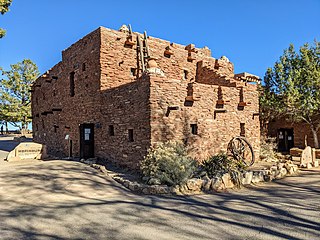
Hopi House is located on the South Rim of the Grand Canyon, within Grand Canyon National Park in the U.S. state of Arizona. Built in 1904 as concessioner facilities at the South Rim were being developed, it is the first of eight projects at the Grand Canyon that were designed by architect Mary Colter, along with Bright Angel Lodge, Hermit's Rest, Lookout Studio, Phantom Ranch, Desert View Watchtower, Colter Hall and Victor Hall,. Hopi House was built by the Fred Harvey Company as a market for Native American crafts, made by artisans on the site. The Hopi, as the historic inhabitants of the area, were chosen as the featured artisans, and the building was designed to closely resemble a traditional Hopi pueblo. Hopi House opened on January 1, 1905, two weeks before the El Tovar Hotel, located just to the west, was opened.
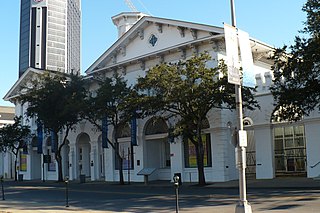
Old City Hall, also known as the Southern Market, is a historic complex of adjoining buildings in Mobile, Alabama, that currently houses the History Museum of Mobile. The complex was built from 1855 to 1857 to serve as a city hall and as a marketplace. It was declared a National Historic Landmark in 1973, as a rare well-preserved example of a 19th-century multifunction civic and commercial building.
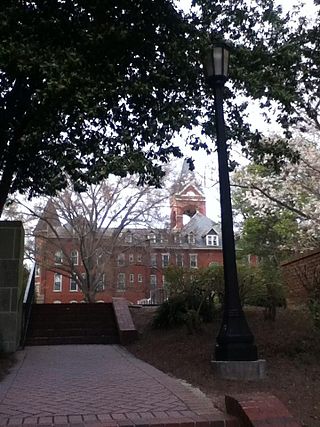
South Candler Street–Agnes Scott College Historic District is a historic district in Decatur, Georgia that was listed on the National Register of Historic Places in 1994. It includes Agnes Scott College, also known as Decatur Female Seminary (1889) and as Agnes Scott Institute (1890-1906), and Little Decatur.

Jackson County Courthouse is a two-story brick building designed by architect W.W. Thomas and built in 1879 in Jefferson, Georgia. Its Classical Revival clock tower was added in 1906. It was one of the first post-Civil War county courthouses built in Georgia. It is unusual for surviving little-altered since construction. In 2004, a new courthouse was built in Jefferson.

Senior Hall is a historic building on the University of California, Berkeley campus, in Berkeley, California. The rustic log cabin structure was designed by architect John Galen Howard. The building was proposed in 1903 and dedicated in 1906. It was originally used as the university's student union and run by the senior male students. A senior honor society called the Order of the Golden Bear was largely responsible for building the hall, and it held secret meetings at the hall after its construction. According to the Daily Californian, Senior Hall was largely responsible for student self-governance at Berkeley, as the hall gave seniors a place to meet and discuss campus issues. A new student union replaced the hall in 1923, but the Order of the Golden Bear continues to meet there.

Frederick Heath was an American architect responsible for numerous projects in Tacoma, Washington. He worked out of his own office and as a senior partner at architectural firms. He was involved with Spaulding, Russell & Heath, and Heath & Gove. His work included designs for several historic and notable schools, churches, stadiums, and commercial properties.

The Architecture of Buffalo, New York, particularly the buildings constructed between the American Civil War and the Great Depression, is said to have created a new, distinctly American form of architecture and to have influenced design throughout the world.

The Delta Psi, Alpha Chapter fraternity house is located at 434 Riverside Drive in the Morningside Heights neighborhood of Manhattan, New York City. It was purpose built in 1898 and continues to serve the Columbia chapter of the Fraternity of Delta Psi, a social and literary fraternity.
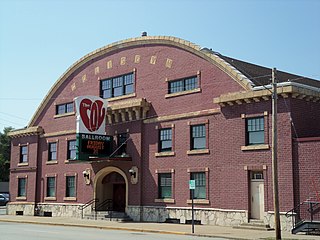
The Col Ballroom is a historic building located in the West End of Davenport, Iowa, United States. It was listed on the National Register of Historic Places and on the Davenport Register of Historic Properties as the Saengerfest Halle.

Henry William Cleaveland was an American architect based in New York, New York, and then San Francisco, California, and Portland, Oregon. He was one of the founding members of the American Institute of Architects, and several of his works have been listed on the National Register of Historic Places. His works include Ralston Hall, a National Historic Landmark in the San Francisco Bay Area, the original Palace Hotel in San Francisco, and the Bidwell Mansion in Chico, California.
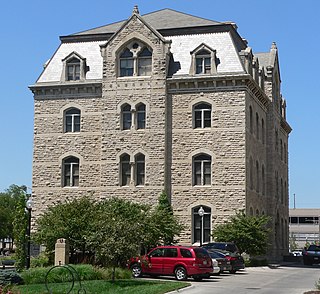
Lincoln City Hall is the former seat of the Lincoln, Nebraska city government. The hall was built from 1874-1879 as the U.S. Post Office and Court House, designed by the office of the U.S. Treasury Department's architect, Alfred B. Mullett. A new post office and court house was built in 1906 and the property was transferred to the city. It was superseded as city hall in 1969 when the city government moved into the City-County Building. Although Mullett is officially listed as the architect, much of the design work may have been carried out by his assistant, William Appleton Potter, who specialized in the Gothic style.

Hodgin Hall, previously known at various times as the University Building, Main Building, or Administration Building, is a historic building on the University of New Mexico campus in Albuquerque, New Mexico. Completed in 1892, it was the first building constructed on the UNM campus and the university's only building for almost a decade. The building was originally designed by Jesse Wheelock in the Richardsonian Romanesque style, but structural problems with the building's roof gave university president William Tight the opportunity to have it remodeled in his preferred Pueblo Revival style in 1908.

Goddard Hall of New Mexico State University is a historic building in Las Cruces, New Mexico. It is located on S. Horseshoe between Espina and Sweet on the NMSU campus. It was listed on the National Register of Historic Places in 1988.

Connor Hall in Santa Fe, New Mexico is a Pueblo Revival-style building which was constructed in 1927 and 1928. Located at 1060 Cerrillos Rd., New Mexico School for the Deaf, it was listed on the National Register of Historic Places in 1988.
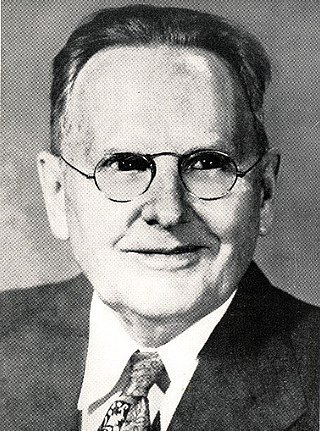
George Awsumb was a prominent Norwegian-American architect in the first half of the 20th century. Awsumb defined architecture as “frozen music” designed for the “man on the street.” He was influenced by his early life, European travels, and prevailing architectural trends of his time. His eclectic, progressive portfolio included neoclassical, Gothic Revival, Prairie School, and International Style designs. Several buildings that Awsumb designed have been in continuous use in the American Midwest and South for over 100 years. In particular, Awsumb began a family architectural legacy that contributed to the progress and development of Memphis, Tennessee.

Bowden Hall is a historic building on the campus of Western New Mexico University in Silver City, New Mexico. It was built as a men's dormitory in 1928, and it was named in honor of a member of the board of regents. The bedrooms were later repurposed as classrooms. It was designed in the Mission Revival architectural style by Trost & Trost. It has been listed on the National Register of Historic Places since September 22, 1988. It currently houses the Department of Humanities.
Otto H. Thorman was an American architect. He designed many houses in the Manhattan Heights neighborhood of El Paso, Texas, as well as several buildings listed on the National Register of Historic Places like the Woman's Club of El Paso and Goddard Hall on the campus of New Mexico State University in Las Cruces, New Mexico.

Zimmerman Library is the historic main library of the University of New Mexico, located near the center of the university campus in Albuquerque, New Mexico. It is one of the largest and most notable buildings designed by New Mexico architect John Gaw Meem and is the centerpiece of the UNM Libraries, the largest library system in New Mexico with almost 4 million print volumes. It was built in 1936–38 with funding from the Public Works Administration and Works Progress Administration, with further additions completed in 1966 and 1973. The building was named for former university president James Fulton Zimmerman in 1961. It was added to the New Mexico State Register of Cultural Properties and the National Register of Historic Places in 2016.



















